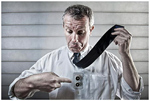Digital Darkroom, an exciting new show at The Annenberg Space for Photography, opened this past weekend and should be required viewing for anyone with a camera — you’ll quickly be inspired to take your creativity to a new level, right at the comfort of your computer. Sponsored by Adobe Photoshop, Digital Darkroom showcases the finest artist working in the new medium displayed in the most advanced digital facility anywhere in the world. The whole family will enjoy seeing the variety of the manipulated images – from dogs dressed as people to incredible athletic portraits to dream-like flights of the imagination by new artists, young and old. The group show features 17 artists working at “the intersection of art and technology” — which reminded me of how Steve Jobs often likened what he did at Apple to an idyllic intersection of Liberal Arts and Science. The show will be open through May 28, 2012 and we highly recommend a visit to this enticing space this holiday season. (It’s pretty easy to dash over from the Century City mall and take a gander).
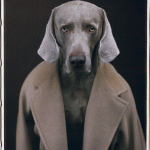 The best thing about the Annenberg is that it takes only a short time to cruise the pristine space (though, be sure to save time to watch the film showing in the central gallery). Kids will quickly be able to tell that some images are obviously manipulated, but Digital Darkroom will help train novice eyes to the seamless abilities of the computer. For instance, kids will love Martine Roch’s portraits of kittens and dogs dressed up as people, and a comparison with the classic images of weimaraners by William Wegman, we can make an elementary comparison of how a computer helps an artist create. Wegman (whose work is not in the show, but click here to see an example) worked in Polaroid film, allowing himself only one shot of his anthropomorphized dogs; it’s easy for the eye to detect the difference between the dressing up dogs and composing animal heads on human bodies as in this Roch shot.
The best thing about the Annenberg is that it takes only a short time to cruise the pristine space (though, be sure to save time to watch the film showing in the central gallery). Kids will quickly be able to tell that some images are obviously manipulated, but Digital Darkroom will help train novice eyes to the seamless abilities of the computer. For instance, kids will love Martine Roch’s portraits of kittens and dogs dressed up as people, and a comparison with the classic images of weimaraners by William Wegman, we can make an elementary comparison of how a computer helps an artist create. Wegman (whose work is not in the show, but click here to see an example) worked in Polaroid film, allowing himself only one shot of his anthropomorphized dogs; it’s easy for the eye to detect the difference between the dressing up dogs and composing animal heads on human bodies as in this Roch shot. 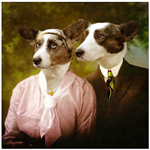 Next, let the kids examine the work of Joel Grimes, whose highly glossed, commercial images marry studio portraits of athletes and celebrities with a composite of exposures of a location. Grimes wants the viewer to see something which appears to be ‘real’ and yet has an aura-of the hyper real. If you watch the film in the central gallery at the Annenberg, Grimes explains how he produces his signature look.
Next, let the kids examine the work of Joel Grimes, whose highly glossed, commercial images marry studio portraits of athletes and celebrities with a composite of exposures of a location. Grimes wants the viewer to see something which appears to be ‘real’ and yet has an aura-of the hyper real. If you watch the film in the central gallery at the Annenberg, Grimes explains how he produces his signature look.
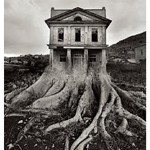 If you have spent any time in your life studying classical black and white photography, from either a technical or an artistic point-of-view, you’ll know the name Jerry Uelsmann. He shocked classical photographers by manipulating images in the darkroom years ago, producing images such as this one that defy realism and suggest a surrealistic world. From the point-of-view of this show, he is considered the granddaddy of a vision that is now commonplace, from advertising to fine art. It was interesting to learn that he is married to one of the most respected digital photographers of the computer-age, Maggie Taylor.
If you have spent any time in your life studying classical black and white photography, from either a technical or an artistic point-of-view, you’ll know the name Jerry Uelsmann. He shocked classical photographers by manipulating images in the darkroom years ago, producing images such as this one that defy realism and suggest a surrealistic world. From the point-of-view of this show, he is considered the granddaddy of a vision that is now commonplace, from advertising to fine art. It was interesting to learn that he is married to one of the most respected digital photographers of the computer-age, Maggie Taylor. 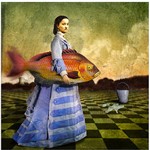 Again, if you take the time to watch the 20 minute film in the central gallery, you’ll understand the technological leap that the computer represents for the artist. Uelsmann and Taylor have highly divergent techniques — he shoots black and white images and then creates everything in the traditional darkroom, dodging and burning separate negatives to create one shot. And she spends her day in a glorious, well-lit studio choosing items from her vast collection of old objects and carefully layers them onto a scanner and then creates images in the computer. For this image, she literally scanned her goldfish!
Again, if you take the time to watch the 20 minute film in the central gallery, you’ll understand the technological leap that the computer represents for the artist. Uelsmann and Taylor have highly divergent techniques — he shoots black and white images and then creates everything in the traditional darkroom, dodging and burning separate negatives to create one shot. And she spends her day in a glorious, well-lit studio choosing items from her vast collection of old objects and carefully layers them onto a scanner and then creates images in the computer. For this image, she literally scanned her goldfish!
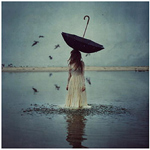 The fantastical imagination of a 24 year-old artist, Brooke Shaden is translated into imagery through a tangible process: first she dreams up an idea and proceeds to pre-visualizes it entirely. Next, she must recreate what was in her mind, choosing a location and models for her shots. After a comparatively brief shooting session on location, Brooke returns to her computer and augments the images in the computer, striving to achieve the dream that she herself had of the image. Teens into Twilight and those who love fairy tales will appreciate her lyrical imagery. The other highly amusing set of images is by a Frenchman who doesn’t even think of himself as an artist; Pierre Beteille wakes up each day and takes a picture of himself, casually expressing whatever mood strikes him. He fiddles around in Photoshop and the result are highly amusing, and yet deeply touching, self-portraits, such as the image above, in which he is going to plug himself in for a day at the office.
The fantastical imagination of a 24 year-old artist, Brooke Shaden is translated into imagery through a tangible process: first she dreams up an idea and proceeds to pre-visualizes it entirely. Next, she must recreate what was in her mind, choosing a location and models for her shots. After a comparatively brief shooting session on location, Brooke returns to her computer and augments the images in the computer, striving to achieve the dream that she herself had of the image. Teens into Twilight and those who love fairy tales will appreciate her lyrical imagery. The other highly amusing set of images is by a Frenchman who doesn’t even think of himself as an artist; Pierre Beteille wakes up each day and takes a picture of himself, casually expressing whatever mood strikes him. He fiddles around in Photoshop and the result are highly amusing, and yet deeply touching, self-portraits, such as the image above, in which he is going to plug himself in for a day at the office.
Click here for a full listing of the artists in the show.
Anyone with a camera and a computer, (whose imagination is in good working order), would be crazy not to play around the way these artists have, pushing boundaries, and finding images for thoughts that only existed in the attics of their minds. As the invention of the camera spurred generations of creative photographers, so the computer pushes the art form even further. With very little barrier to entry, it seems only natural that everyone try.

